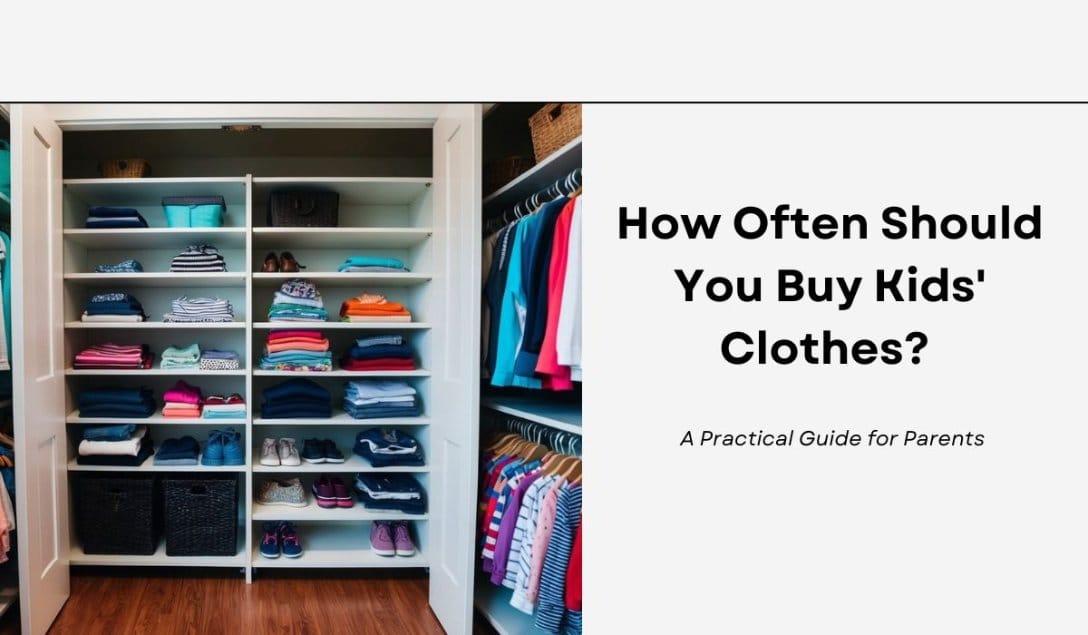A Parent’s Guide to Smart Wardrobe Planning and Strategic Shopping
Kids grow fast, and their clothing needs change quickly. Many parents wonder how often they should buy new clothes for their children. The answer depends on several factors, including the child’s age, growth rate, and lifestyle.
Children typically need new clothes every 3-4 months during their first year, and then every 6 months until they reach school age. After that, buying new clothes once or twice a year is usually enough. Of course, this can vary based on individual growth spurts and wear and tear.
Parents can save money on children’s clothes by shopping smart. Look for sales, accept hand-me-downs, and consider second-hand shops. It’s also wise to keep an eye on your child’s wardrobe and replace items as needed, rather than buying in bulk.
On This Page
Key Takeaways
- Children’s clothing needs change rapidly, requiring frequent updates
- Smart shopping and budgeting help manage clothing expenses
- A well-planned wardrobe balances practicality with occasional special items
Understanding Children’s Growth and Clothing Sizes
Children grow quickly, making it challenging to keep them in well-fitting clothes. Knowing how to use sizing charts and choose adjustable garments can help parents make smarter purchases.
Importance of a Sizing Chart
Sizing charts are essential tools for buying children’s clothes. They provide key measurements like height, weight, chest, and waist. These charts help parents choose the right size without trying clothes on.
It’s wise to measure your child every few months. Children can grow rapidly, sometimes jumping several sizes in a year.
Many brands offer their own sizing guides. These can vary, so it’s best to check each time you shop. Some charts include age ranges, but these are just rough guides. A child’s actual measurements are more reliable.
Adjustable Features for Extended Use
Adjustable clothing features can help clothes last longer as children grow. Waistbands with elastic or buttons allow trousers to fit for longer periods.
Shirts and dresses with roll-up sleeves offer flexibility. These can be worn in different seasons or as the child grows taller.
Some coats have extendable sleeves hidden inside the cuffs. This clever design lets the coat grow with the child.
Adjustable straps on dungarees and pinafores also add longevity to these items. They can be loosened as the child gets taller.
Assessing Your Child’s Current Wardrobe
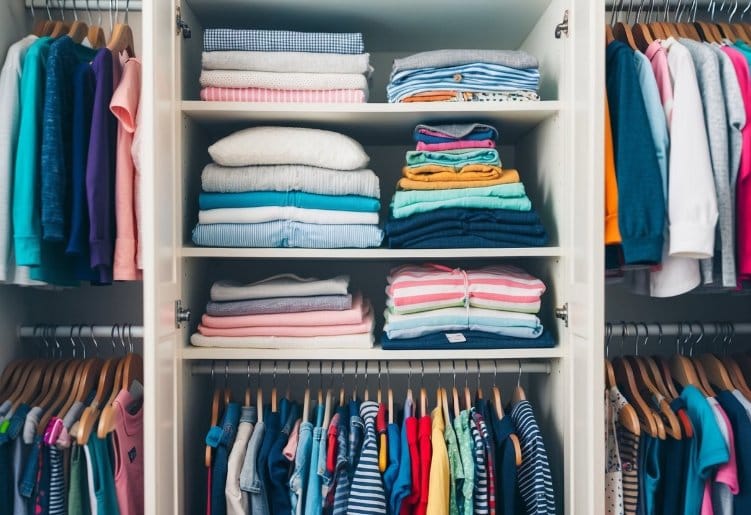
Taking stock of your child’s clothes helps you make smart buying decisions. A regular review ensures they have what they need without excess.
Decluttering Outgrown Items
Start by sorting through all clothing items. Remove anything that’s too small, worn out, or damaged beyond repair. Create a checklist of what your child actually wears and needs. This helps focus on essentials.
Be realistic about your child’s preferences and lifestyle. If they never wear certain types of clothes, don’t keep them. Consider donating or selling items in good condition.
Aim for a minimalist wardrobe for kids. This makes getting dressed easier and reduces clutter. Keep only clothes that fit well and are comfortable.
Ensuring Essential Items Are Available
After decluttering, check what’s left. Make sure your child has enough everyday basics like:
- Underwear and socks
- T-shirts and long-sleeved tops
- Trousers or leggings
- Jumpers or cardigans
- Shoes for different activities
Consider the climate and your child’s activities. Do they need warm coats for winter? Swimwear for summer? Sports kit for school?
Check that clothes fit properly and are in good condition. Replace worn-out basics promptly. This helps maintain a functional wardrobe without constant shopping trips.
How Often to Buy New Clothes
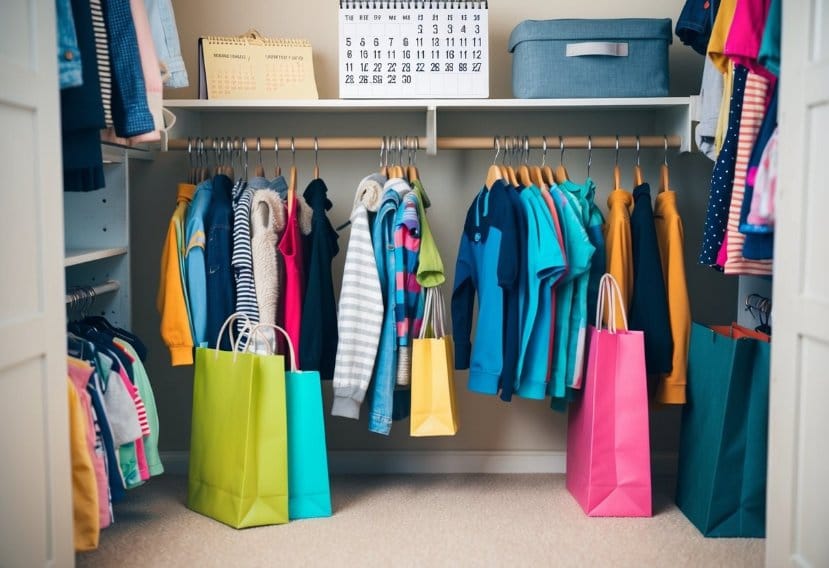
Kids grow quickly, so their clothing needs change regularly. Buying new clothes depends on growth spurts, wear and tear, and seasonal changes. Let’s look at typical update frequencies and signs it’s time for new items.
Typical Frequency for Updating Wardrobes
Most parents buy new clothes for their children every 6-12 months. Growth rates vary, but this timeframe often aligns with size changes. Some parents prefer buying clothes in larger sizes to last longer.
For seasonal items, shopping twice a year is common. This allows for summer and winter wardrobe updates. Spring and autumn clothing can often overlap with these main seasons.
Everyday items like socks and underwear may need more frequent replacement. These typically wear out faster due to regular use and washing.
Signs That It’s Time to Purchase New Items
Several indicators suggest it’s time to buy new clothes for children:
- Trousers or sleeves becoming too short
- Shirts riding up or not tucking in properly
- Shoes feeling tight or leaving marks on feet
- Visible wear and tear, such as holes or faded colours
- Seasonal changes requiring different types of clothing
It’s important to regularly check the fit of children’s clothes. A good rule of thumb is to assess the wardrobe at the start of each season. This helps identify any gaps or items that no longer fit.
Some parents find it helpful to keep a list of needed items. This can prevent overbuying and ensure all essential pieces are covered.
Choosing the Right Clothes for Different Occasions
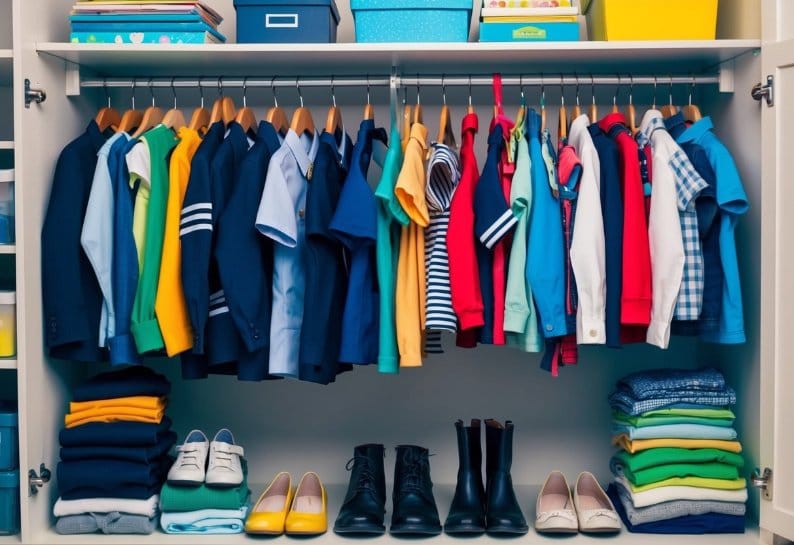
Kids need a mix of casual and dressy clothes for various activities. The right outfits and footwear help children feel comfortable and confident in any setting.
Play Clothes Versus Special Occasion Outfits
Play clothes should be durable and easy to clean. Choose comfortable fabrics that can withstand rough-and-tumble play. Look for stretchy materials that allow freedom of movement.
For special occasions, select outfits that are a bit dressier. Consider the event type when choosing. A wedding might call for smarter attire than a birthday party.
It’s wise to have a few versatile pieces that can be dressed up or down. A plain shirt paired with nice trousers or a skirt can work for many events.
Selecting Appropriate Footwear for Activities
The right shoes are crucial for comfort and safety. For everyday play, trainers with good support are ideal. They protect feet during active play and sports.
For special events, smart shoes or sandals can complete an outfit. Ensure they fit well to avoid blisters or discomfort.
Consider the activity when choosing footwear. Water shoes for the beach, wellies for rainy days, and smart shoes for formal events are all important.
Always pick shoes that are the correct size. Children’s feet grow quickly, so check the fit regularly.
Embracing Sustainability and Affordability
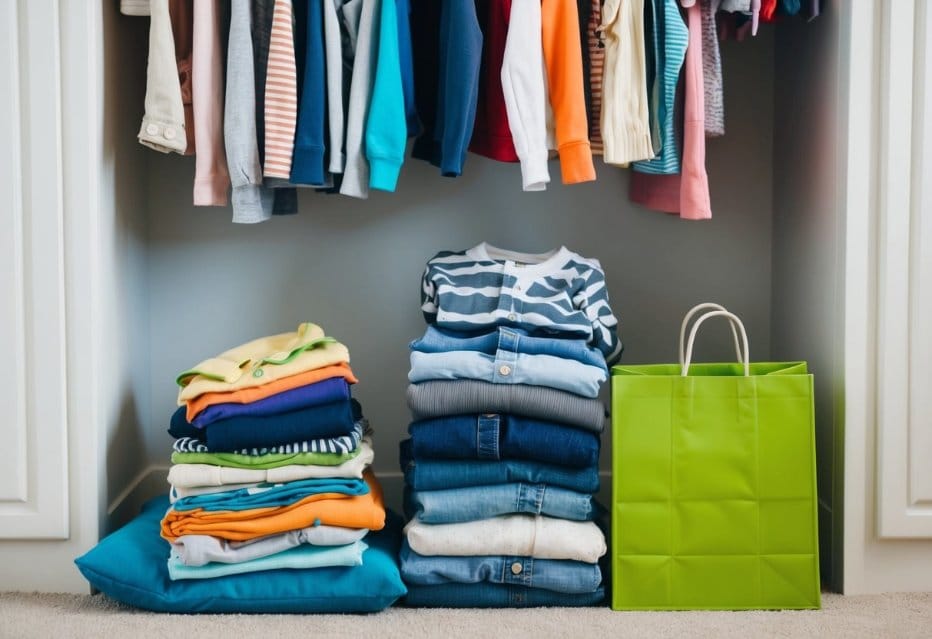
Buying children’s clothes can be both eco-friendly and budget-friendly. There are ways to dress kids well without breaking the bank or harming the planet.
Exploring Second-Hand Options
Thrift stores and charity shops offer great deals on gently used kids’ clothes. These shops often have high-quality items at a fraction of the cost of new clothes.
Online marketplaces are another good option. They let you browse a wide range of second-hand kids’ clothes from the comfort of home.
Community swap events are becoming more popular. Parents can trade clothes their kids have outgrown for items that fit.
Buying second-hand keeps clothes out of landfills. It also reduces demand for new products, which helps the environment.
The Benefits of Receiving and Giving Hand-Me-Downs
Hand-me-downs are a time-tested way to save money on kids’ clothes. Older siblings’ outgrown clothes can be passed down to younger ones.
This practice extends the life of clothes and cuts down on waste. It also teaches children about reusing and valuing what they have.
Sharing hand-me-downs between friends or family members builds community. It creates a cycle of giving that benefits everyone involved.
For items that can’t be handed down, consider donating to local charities. This ensures clothes find new homes rather than ending up in the bin.
Selecting Fabrics and Materials for Comfort
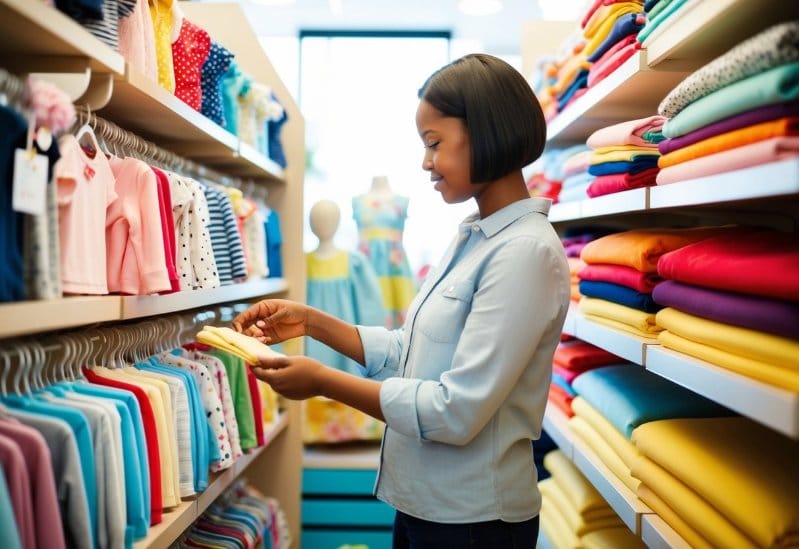
When buying kids’ clothes, fabric choice is key. The right materials can keep children comfy and happy all day long.
The Advantage of Soft and Breathable Fabrics
Soft fabrics are a must for children’s clothing. They feel nice against the skin and don’t cause itching or irritation. Cotton is a top pick for its softness and natural feel.
Breathable fabric helps kids stay cool and dry. It lets air flow and wicks away sweat. This is great for active children who love to run and play.
Organic cotton is a smart choice for sensitive skin. It’s grown without harsh chemicals, making it gentle and safe.
Look for clothes made with a mix of soft and stretchy fabrics. These allow for easy movement and growth. Jersey knit, for example, is both soft and flexible.
Avoid stiff or scratchy materials. These can be uncomfortable and may lead to skin issues. Instead, opt for smooth, lightweight fabrics that feel good to touch.
Maintaining a Child’s Wardrobe on a Budget
Keeping children clothed without breaking the bank requires careful planning and smart shopping. A few key strategies can help parents build a functional wardrobe for their little ones whilst saving money.
Smart Shopping Strategies
Look for sales and clearance events to stock up on essentials. Many shops offer steep discounts at the end of each season. Buy clothing a size up so kids can grow into them.
Consider second-hand options like charity shops or online marketplaces for gently used items. Hand-me-downs from family or friends can be a great way to save.
Sign up for email lists from favourite children’s clothing brands to get notified of promotions. Some offer loyalty programmes with additional savings.
Buy multi-packs of basics like vests, pants, and socks. These often cost less per item than buying singles.
Identifying Long-Lasting Basics
Focus on building a basic wardrobe with versatile, mix-and-match pieces. Choose neutral colours that can be paired easily.
Invest in quality for items worn frequently, like jeans or trainers. These may cost more upfront but will last longer.
Look for adjustable features like elastic waistbands or roll-up cuffs to extend wear time as children grow.
Opt for durable fabrics like cotton for everyday wear. Avoid delicate materials that may not withstand active play or frequent washing.
For babies, stock up on bodysuits and sleepsuits from brands like Carter’s. These form the foundation of an infant’s wardrobe and are often reasonably priced.
Frequently Asked Questions
Parents often wonder about the best practices for maintaining their children’s wardrobes. The following questions address common concerns regarding the frequency of purchases, appropriate quantities, and factors that influence clothing needs.
How frequently should children’s wardrobes be updated?
Children typically need new clothes every 3-4 months due to rapid growth. Toddlers may require more frequent updates, while older children might need less.
Seasonal changes and growth spurts can affect this timeline. It’s wise to assess a child’s wardrobe at the start of each season.
What is the appropriate number of garments for a child’s wardrobe?
Most children need 9-12 outfits per season. This allows for a fresh outfit each day with a few extras for unexpected messes.
Toddlers might require up to 12 outfits due to frequent spills. Older children can manage with 9-10 outfits per season.
At what stage do you typically cease purchasing clothing for children?
There’s no set age to stop buying clothes for children. Most parents continue purchasing until their child can afford their own clothing or reaches adulthood.
The frequency of purchases often decreases as children grow older and their growth rate slows down.
Are garments labelled 0 to 3 months identical to those described as newborn?
Newborn and 0-3 month sizes are not identical. Newborn sizes are generally smaller and fit babies up to 8-9 pounds.
0-3 month sizes typically fit babies from 8-12 pounds. It’s best to have a mix of both for a newborn’s wardrobe.
What indicators suggest it’s time to refresh a child’s clothing collection?
Key signs include:
1. Clothes becoming too tight or short
2. Visible wear and tear
3. Stains that won’t come out
4. Seasonal changes requiring different types of clothing
How do seasonal changes affect the frequency of purchasing children’s attire?
Seasonal changes often prompt clothing purchases. Winter requires warm layers, while summer calls for lighter fabrics.
Parents typically buy seasonal items at the start of each season. Some may purchase a size up to ensure clothes fit throughout the season.
Related Post: Why are kids picky about clothes? Understanding the psychology behind children’s fashion choices

